Oral Cancer Screening In Mississauga
Early cancer detection for the mouth, lips, tongue or throat. Learn the signs and understand your risks.
Oral cancer is characterized from abnormal cell growth in the mouth, lips, tongue or throat. With early detection, oral cancers have a high rate of successful treatment. The people at the greatest risk for oral cancers are those over the age of 45 but regardless of your age, you should opt for oral cancer screening if you’ve experienced any of the following symptoms:

The goal of an oral cancer screening is the early detection of cancer or precancerous conditions in your mouth. During the exam, your dentist will look over the inside of your mouth and under your tongue for red or white patches or suspicious sores. Your dentist will also feel the tissues in your mouth to check for lumps or odd textures and may also feel the outside of your throat and neck for lumps.

If signs of cancer are detected during your oral screening you may be asked to undergo additional testing such as a biopsy (where a small piece of the suspicious tissue is removed for lab examination) or imaging tests like Xrays, ultrasounds, CT scans or an MRI. To remove confirmed tumours, surgery or chemotherapy or radiation therapy may be necessary.

You can take steps now to help prevent oral cancer later. To help reduce your risk of oral cancer see your dentist regularly for routine exams, stop using tobacco products and drink responsibly, be mindful of your exposure to direct sunlight and use U/V protective lip balms, eat a healthy diet with plenty of fruits and veggies and during your routine brushing and flossing rituals, remember to check your mouth for signs or symptoms so that you can report any concerns to your dentist.
There are several behaviours and conditions that are associated with a higher risk of oral cancer. These include:
If you have any of the risk factors for oral cancer it’s a good idea to ask for an oral cancer screening at your regular dental exam. If you have discovered an unusually coloured or textured patch in your mouth or a lump or suspicious sore you’re encouraged to schedule an appointment to get it checked out.
Your dentist will examine your lips and the inside of your mouth including your cheeks, gums and all sides of your tongue. They will also carefully feel around for any lumps or unusual textures. The dentist may also feel your face, jaw, throat and neck for unusual lumps or tenderness.
Wash your hands with warm soapy water. In front of your bathroom mirror, you’ll want to examine the roof of your mouth, your lips, tongue and gums. Pull your top lip up and bottom lip down to see behind them. You may use a piece of gauze or a cotton pad to help you grip your tongue to check the sides and underside. Do your best to look at your gums, and use your fingers to feel the insides of your mouth. You’re looking and feeling for colour changes, lumps and bumps, unusual textures or tenderness. Let your dentist know if you have any sores that have not healed after two weeks.
Small, usually painless, flat patches that may appear red, white, gray or yellow with red edges. These small patches can affect any area of the mouth including the lips, gums, cheeks, tongue and the roof of the mouth. As a good rule of thumb, it’s a good idea to have anything that looks or feels unusual checked out by your doctor or dentist.
1528 Dundas St. W. Unit #3, Mississauga, ON L5C 1E4
Call / Text +1 (905) 896-8116
© 2025 Mississauga Family Dentistry.